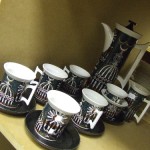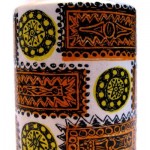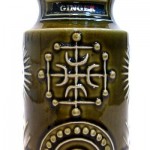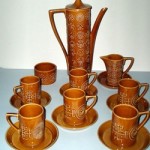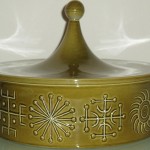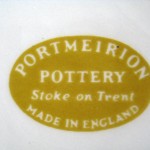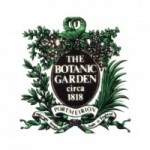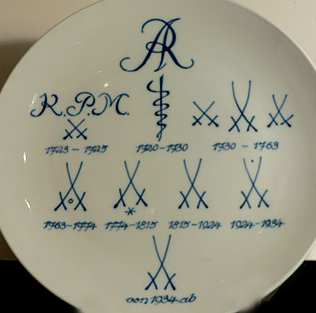Portmeirion Pottery’s most famous design is Botanic Garden but the company has produced a wide range of pottery from the sumptuous to the bizarre. Of course, designer Susan Williams-Ellis is the daughter of Sir Clough Williams-Ellis, the creator of the bizarre village of Portmeirion so it is no wonder that she has produced some extraordinary pottery designs.
Perhaps the surprising thing is that the most popular designs use 19th century botanic illustrations and have been wildly successful in the UK, USA and elsewhere.
 Although Susan Williams-Ellis died at the age of 89 on 27th November, 2007, the company continues and still comes out with new designs and products so keeping to the spirit alive of its founder.
Although Susan Williams-Ellis died at the age of 89 on 27th November, 2007, the company continues and still comes out with new designs and products so keeping to the spirit alive of its founder.
Portmeirion Pottery is made in Stoke-on-Trent. There are strong connections to Sir Clough Williams-Ellis’ Portmeirion Village in Wales. His daughter, Susan Williams-Ellis, who studied at the Chelsea School of Art under Sir Henry Moore and Graham Sutherland, designed pottery exclusively for the Portmeirion gift shop in the 1950s.
In 1960, she and her husband, Euan Cooper-Willis, bought the pottery decorating business of A.E. Gray Ltd which she had been using to produce her designs. The following year they bought Kirkham’s Ltd, a pottery manufacturing company and they renamed the entire business Portmeirion Potteries. These acquisitions allowed Susan to design both the shapes and surface patterns, an unusual thing for a designer to do at that time.
Collecting Portmeirion Pottery
Portmeirion Pottery attracts keen collectors. Some boast a collection of 4000 pieces and collect across the whole range of Portmeirion. Others concentrate on particular designs like Botanic Garden or Magic Garden. Then there are collectors who buy Portmeirion because it overlaps with their area of collecting like the chemist’s advertisements.
Currently, many pieces can be bought at very reasonable prices. Depending on the design, you can expect to pay from £25 to £5000 for one of the company’s distinctive, tall coffee pots. Looking at pieces in auctions over the past year, it is possible to buy Portmeirion in mixed lots at very reasonable prices, possibly because few dealers are buying it at the moment. eBay is another good place to look for Portmeirion Pottery.
Prices of the designs produced in small quantities like Malachite, Moss Agate and Magic Garden, are going to be more expensive.
As time goes on, though, prices are almost certain to rise so, if you want to collect Portmeirion Pottery, now is the time to start.
Portmeirion Early Designs
In 1963, Susan Williams-Ellis‘ first design for Portmeirion Potteries was made from tubular moulds she found at the factory. She used different diameters and cut them to varying lengths to produce the revolutionary tall, straight coffee service she called Totem. It became an immediate success. It was made in deep colours: blue, amber, olive, and had embossed stars, spirals and stars as decoration. To prove its timeless quality, the design has been relaunched recently.
 Susan Williams-Ellis had already produced one of her most expensive designs. During the 1950s she had designed fabric based on the mineral malachite for use as curtains in Portmeirion’s hotel. After she and her husband bought A.E. Gray, she reproduced the design in pottery. Malachite was very expensive to make especially as it was sumptuously gilded so few pieces were produced, making it very collectable now.
Susan Williams-Ellis had already produced one of her most expensive designs. During the 1950s she had designed fabric based on the mineral malachite for use as curtains in Portmeirion’s hotel. After she and her husband bought A.E. Gray, she reproduced the design in pottery. Malachite was very expensive to make especially as it was sumptuously gilded so few pieces were produced, making it very collectable now.
Moss Agate was another early design only made in small quantities due to the costs involved. This time Susan used engravings of the semi-precious mineral moss agate as the pattern. The design was transferred, usually on to bone china, and then gold was applied to the motifs before firing giving an embossed look.
Now one of the most collectable and desirable of these other designs is Magic Garden. Stephen McKay says that the decoration is meant to show the flowers, birds and plants that astronauts might find on the moon. Because it was not popular when introduced so not many pieces were produced so now rarity adds to its attractions and value. It was a follow-up to the hugely successful Magic City’s Eastern influenced design, brought out in 1966.
At the time of her death in 2007, it was calculated that that range alone had accounted for worldwide sales of $450 million in its 35 years of existence, while Portmeirion was, as the Daily Telegraph’s obituary pointed out, now ‘one of the world’s most successful ceramics companies’.


